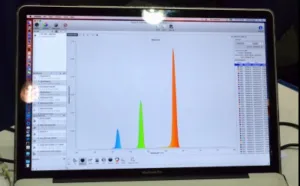PixelDisplay CTO, David Wyatt, is a passionate salesman, and he frequently gathered a small crowd around him as he discussed the introduction of his company’s Vivid Color light-source technology at his I-Zone booth at SID Display Week, held May 23-25, 2017.

It was Wyatt’s confident claims of across-the-board superiority — including superiority over OLEDs and quantum dots — and the good-looking live spectral displays of his Vivid Color sources that drew the crowdlets. But it wasn’t easy to piece together what PixelDisplay was actually doing.
Attending the paper authored by Wyatt and by Haiwei Chen and Shin-Tson Wu of the Univ. of Central Florida (which was the last paper of the conference) and its Q&A made things a lot a clearer. Most of the paper consisted of a careful and useful primer on the contributants to color gamut in displays, with spectra and measurement results. (I’m inclined to attribute this good work to Wu — who I know as a leading display researcher — and Chen.)
![]() One of the comparison spectra shown at the PixelDisplay booth in the I-Zone. (Photo: Ken Werner)
One of the comparison spectra shown at the PixelDisplay booth in the I-Zone. (Photo: Ken Werner)
But once you got past the general information, it became clear that what PixelDisplay was actually making is an LED enhanced with red and green phosphors. Now, despite Wyatt’s claims of novelty, RG-enhanced LEDs have been around for quite a while. Sharp sold a premium TV set with such LEDs several years ago, and Samsung has them in its 2017 MU family of premium TVs.
The claim of novelty could be justified by new phosphor formulations, but in answering a question during the Q&A, Wyatt said that PixelDisplay was using commercially available phosphors.
Adding Insult to Revelation…
Along the way, Wyatt insulted the many members of the display community who work on these systems. He implied the community did not appreciate the fact that white LEDs produce emissions in red and green that lack both strength and purity. Of course, this is very well understood, and is the motivation behind quantum dots, the RG-enhanced LEDs that have preceded VividColor, and other solutions such LG’s Nano Cell.
In passing, Wyatt suggested you could put more than two enhancing phosphors in the LED package, implying strongly that multi-primary displays were a new idea. In fact, they have been the subject of active R&D for years, and Sharp sold a multi-primary TV set (the Quattron) for a couple of years.
So, although RG-enhanced LEDs clearly constitute a valuable approach to widening the color gamut of LCDs, it is hard to see that PixelDisplay is bringing anything new to the table. I welcome good counter-arguments for this conclusion, and, if they come forth, I will happily write about them in a follow-up column.
I enjoy pouring a glass of new wine.
Ken Werner is Principal of Nutmeg Consultants, specializing in the display industry, manufacturing, technology, and applications, including mobile devices and television. He consults for attorneys, investment analysts, and companies re-positioning themselves within the display industry or using displays in their products. He is the 2017 recipient of the Society for Information Display’s Lewis and Beatrice Winner Award. You can reach him at [email protected].

